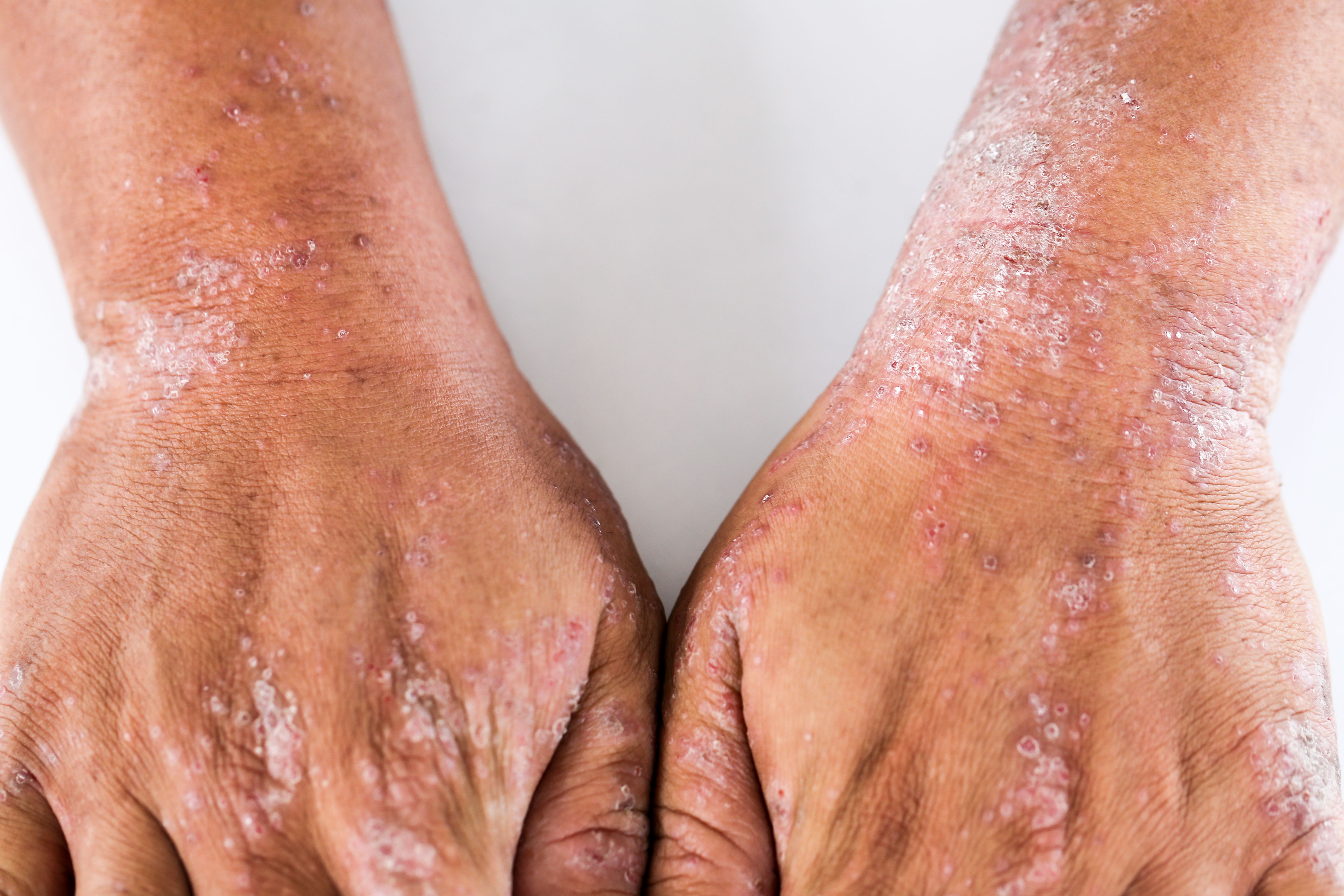Efficacy of Tapinarof Cream 1% Demonstrated in Atopic Dermatitis in Skin of Color
A lack of diversity in clinical trials has hampered health care providers from understanding the nuances of diseases across specific patient populations.
Newly announced phase 3 data of tapinarof cream, 1% (Vtama) highlights the efficacy of the potential topical atopic dermatitis (AD) treatment in adult and pediatric patients down to 2 years of age with skin of color, according to a press release from Dermavant Sciences.
Data from a pair of identical, phase 3, double-blind, randomized, and vehicle-controlled trials (ADORING 1 [NCT05014568]; ADORING 2 [NCT05032859]) were presented at the 2024 American Academy of Dermatology (AAD) Annual Meeting in San Diego, California.
Results of 2 studies of tapinarof cream 1% are promsing for an AD treatment effective across racial groups and skin types. | Image credit: sinhyu - stock.adobe.com

The primary endpoint in ADORING 1 (n = 407) and ADORING 2 (n = 406) was the Validated Investigator Global Assessment for Atopic Dermatitis (vIGA-AD) score of 0 (clear) or 1 (almost clear), and a ≥2-grade improvement from baseline at Week 8.
The achievement of a 75% or greater improvement in the Eczema Area and Severity Index (EASI75) was a key secondary outcome.
At AAD, data from the trials revealed approximately 50% of patients who enrolled had skin of color:
Demographics at baseline:
- 8.8% to 15.3% were Asian
- 26.5% to 35.0% were Black/African American
- 2.7% to 5.2% were American Indian, Alaska Native, Native Hawaiian, Pacific Islander, or other/multiple races, according to Dermavant Sciences)
- 44.8% to 56.8% were White
"Patients with Fitzpatrick skin types IV, V, and VI (most representative of populations with skin of color) represented 23.8% - 25.1%, 20.6% - 22.2%, and 7.6% - 8.9% of patients, respectively, across ADORING 1 and ADORING 2," stated Dermavant in the press release.
Among Asian patients in ADORING 1 (n = 26), 39.5% of those treated with tapinarof cream met the primary endpoint and 47.6% achieved the EASI75 secondary endpoint compared to 3.7% and 20.2% in the vehicle group (n = 10), respectively.
In ADORING 2, among Asian patients in the tapinarof group (n = 39), 48.9% achieved the primary endpoint and 76.6% achieved the secondary endpoint, compared to 18.5% and 17.7% in the vehicle group (n = 23), respectively.
For the ADORING 1 trial, 70 Black or African American patients were in the tapinarof group. Among these patients, 47.0% achieved the primary endpoint and 55.3% achieved the secondary endpoint. This compared to 38 Black patients in the vehicle group, of which 17.5% achieved the primary endpoint and 30.0% achieved the secondary outcome, respectively.
Among Black and African American patients in ADORIING 2 who received tapinarof cream, 1% (n = 95), 43.1% met the primary endpoint while 48.9% met the secondary endpoint compared to 24.1% and 25.7% in the vehicle group (n = 47).
READ MORE: Dupilumab Safe, Effective for Atopic Dermatitis in Real-Life Settings
For White patients in ADORING 1 who received tapinarof cream, 1% (n = 152), 49.4% met the primary endpoint and 61.4% achieved the secondary outcome. In the vehicle group (n = 79), 12.2% met the primary outcome and 19.6% met the secondary EASI75 outcome.
In ADORING 2, 124 White patients received tapinarof cream, 1%. Among this group, 52.1% reached the primary outcome while 67.8% achieved the secondary outcome, compared to 14.5% and 20.7% of patients in the vehicle group (n = 58), respectively.
“Atopic dermatitis is a dermatological condition that can affect people from all racial and ethnic backgrounds and skin types," said Andrew F. Alexis, MD, MPH, vice-chair, Diversity and Inclusion, Department of Dermatology; professor, Clinical Dermatology, Weill Cornell Medicine; dermatologist, New York-Presbyterian/Weill Cornell Medical Center, in the press release.
"Treating diverse patients involves recognizing nuances in specific populations, which historically has been hampered by a lack of data for people of color, exacerbated by their underrepresentation in clinical trials."
Among adverse events in the ADORING trials, most were mild or moderate, with the most frequent adverse events (≥5% in any group) being folliculitis, headache, and nasopharyngitis.
“Today’s data on treatment of patients with skin of color highlight [tapinarof] cream’s promise across all racial groups and skin types in the pivotal trials. This is an example of innovation that may help clinicians improve the treatment journey for patients with atopic dermatitis,” said Alexis.
On February 14, 2024, Dermavant submitted a supplemental New Drug Application (sNDA) to the FDA for tapinarof cream, 1% for the treatment of AD in adults and children aged 2 years and up.
READ MORE: Dermatology Resource Center
This article originally appeared on Contemporary Pediatrics.
Reference
1. Dermavant presents new data on treatment of patients with skin of color from ADORING 1 and ADORING 2 phase 3 pivotal trials of VTAMA (tapinarof) cream, 1% in adults and children 2 years of age and older with atopic dermatitis at the 2024 American Academy of Dermatology Annual Meeting. News release. Dermavant Sciences. March 8, 2024. Accessed March 18, 2024. https://www.dermavant.com/dermavant-presents-new-data-on-treatment-of-patients-with-skin-of-color-from-adoring-1-and-adoring-2/
Examining the State of Benzoyl Peroxide-Containing Acne Products After Benzene Contamination
April 10th 2024Christopher Bunick, MD, PhD, FAAD, an associate professor of dermatology and a physician-scientist at the Yale School of Medicine in New Haven, Connecticut, presented updates on benzene in BPO at the 2024 American Academy of Dermatology Annual Meeting.